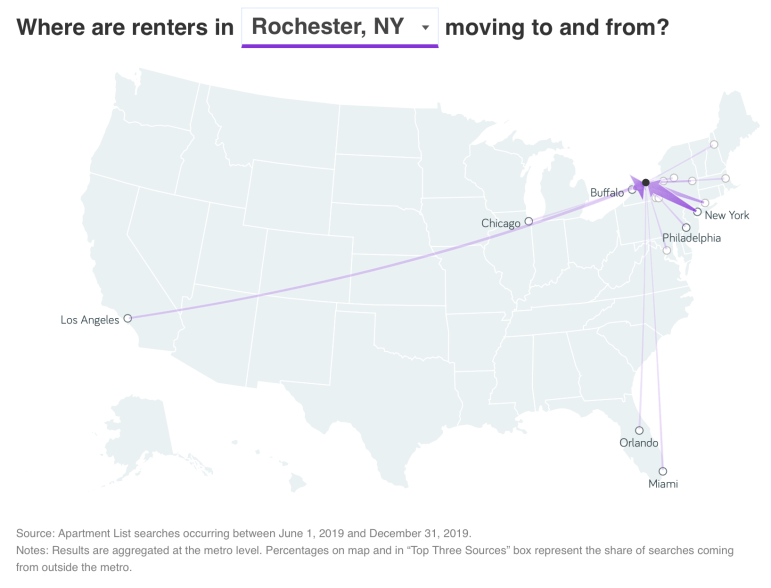The latest Census Bureau report on U.S. population change contained more dispiriting news for New York, continuing recent years’ downward trend.
The data released Dec. 30 for the period July 1, 2018, to July 1, 2019, show that among the 10 states that saw population declines, New York suffered the biggest drop: 76,790. On a percentage basis, its ranking was only slightly better; the Empire State shrank at the third-fastest rate.
New York’s population decline occurred even though births statewide outnumbered deaths by 58,107, and 45,753 immigrants moved to the state. That 103,860 increase failed to keep pace with—let alone surpass—the number of people leaving New York. Outmigration totaled 180,649.
Where are New Yorkers going? An analysis by the Empire Center for Public Policy points south; from 2011 to 2018, Florida was the leading destination, accounting for 21.3 percent of the net total. In that period, nearly 7,000 Monroe County residents relocated to Florida.

The Empire Center’s methodology—using IRS migration data covering two-year segments from 2010-11 to 2017-18—provides the big picture. But it’s hard to tell from the data who is moving from New York to Florida. Common sense says many of these people are retirees.
What about younger residents of the Rochester region? A new report from Apartment List, a rental property search engine, offers some clues, if not a complete answer.
Apartment List analyzed millions of searches by its users from June 1 to Dec. 31. Each user’s current place of residence was defined by the IP address from which the user searched.
Migration data from the Census Bureau tracks moves that have already taken place; by contrast, “search data from platforms such as Apartment List can help supplement our understanding of migration patterns by serving as a leading indicator that shows where renters are looking to move before those moves have actually occurred,” the company states.
In terms of outbound searches by Rochester residents, no Florida city ranks in the top half-dozen. No. 1 is New York City, with 9.3 percent of searches, followed by Buffalo (6.2 percent) and Syracuse (5.3 percent). They are followed by Boston (4.4 percent), Washington, D.C., (3.6 percent) and Charlotte, N.C. (3.1 percent). The top Florida city for outbound Rochester searches is Tampa (2.9 percent).
So, by far the state where Rochester residents would prefer to rent is … New York.

The results for Buffalo and Syracuse are similar. Nearly one in four outbound searches in Buffalo are for Rochester (24.7 percent), followed by New York City (7 percent) and Los Angeles (3.1 percent). The top three for Syracuse are New York (13.5 percent), Albany (8.6 percent) and Rochester (5.6 percent).
The Apartment List data also show that only 27 percent of searches in Rochester are for locations outside of this region. That suggests nearly three-quarters (73 percent) of users are looking for a place to rent not far from where they currently live, not someplace with rock-bottom tax rates or 300 days of sunshine each year.
Among the 25 largest metros nationwide, a Florida city—Orlando—has the highest rate of Apartment List users searching for a rental apartment outside their metro area. (In other words, people eager to live somewhere else.) At roughly 50 percent, it’s nearly twice as high as Rochester. Other cities with high rates of renters looking to leave include Riverside, Calif.; Chicago; Charlotte; Washington, D.C.; San Francisco; and Detroit (perhaps the only city among those that seems like no surprise).

The data on inbound searches for Rochester is revealing too. The top three cities in terms of current residents looking to find a rental apartment here are New York (21.1 percent), Buffalo (18.9 percent) and Bridgeport, Conn. (10.2 percent). In fourth place, at 4.8 percent, is Los Angeles.
Apartment List acknowledges that its users “are not fully representative” of the entire American population; they likely are younger and maybe more affluent. If that’s true, it suggests that members of a key demographic—people in or yet to start their prime earning years—are not looking to flee Rochester en masse.
It’s also true, however, that some people don’t make a big move because they feel stuck—they can’t find a good job elsewhere or lack the financial cushion to help them take the leap. Nationwide, people are relocating at the lowest rate since the Census Bureau started keeping track more than a half-century ago.
Perhaps it’s safe to say only that population change in Rochester and many other cities is more complex than it’s often described.
Paul Ericson is Rochester Beacon executive editor.
Lee, terrific idea!! Too bad that Trump’s followers don’t understand how damaging many (all?) of his policies are.
In the past out-migration of NY residents was offset by in-migration due to immigration. With Trump’s current anti-immigrant policies and aggressively pursuing deportation, immigration has shrunk and therefore our population has shrunk correspondingly. Perhaps instead of a foolish bigoted and racist anti-immigration policy if we ENCOURAGED immigration in NY State we’d have fewer issues due to a shrinking population. Immigration is a net positive for our economy as proved by any number of studies. Creating a better legal immigration process with fewer roadblocks and more help for new immigrants would be a boon for NYS.